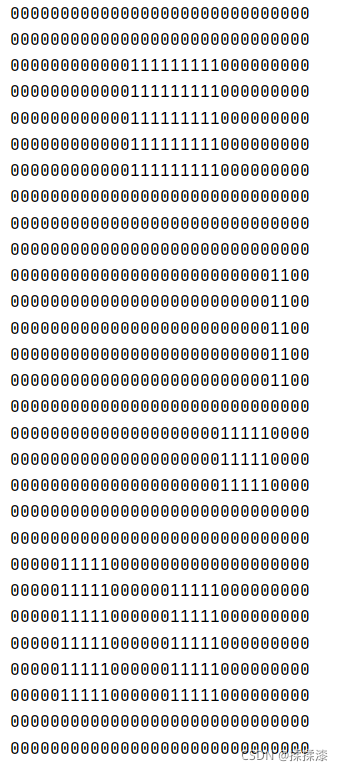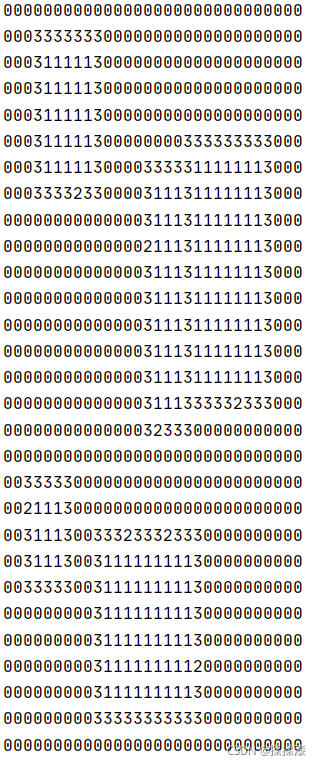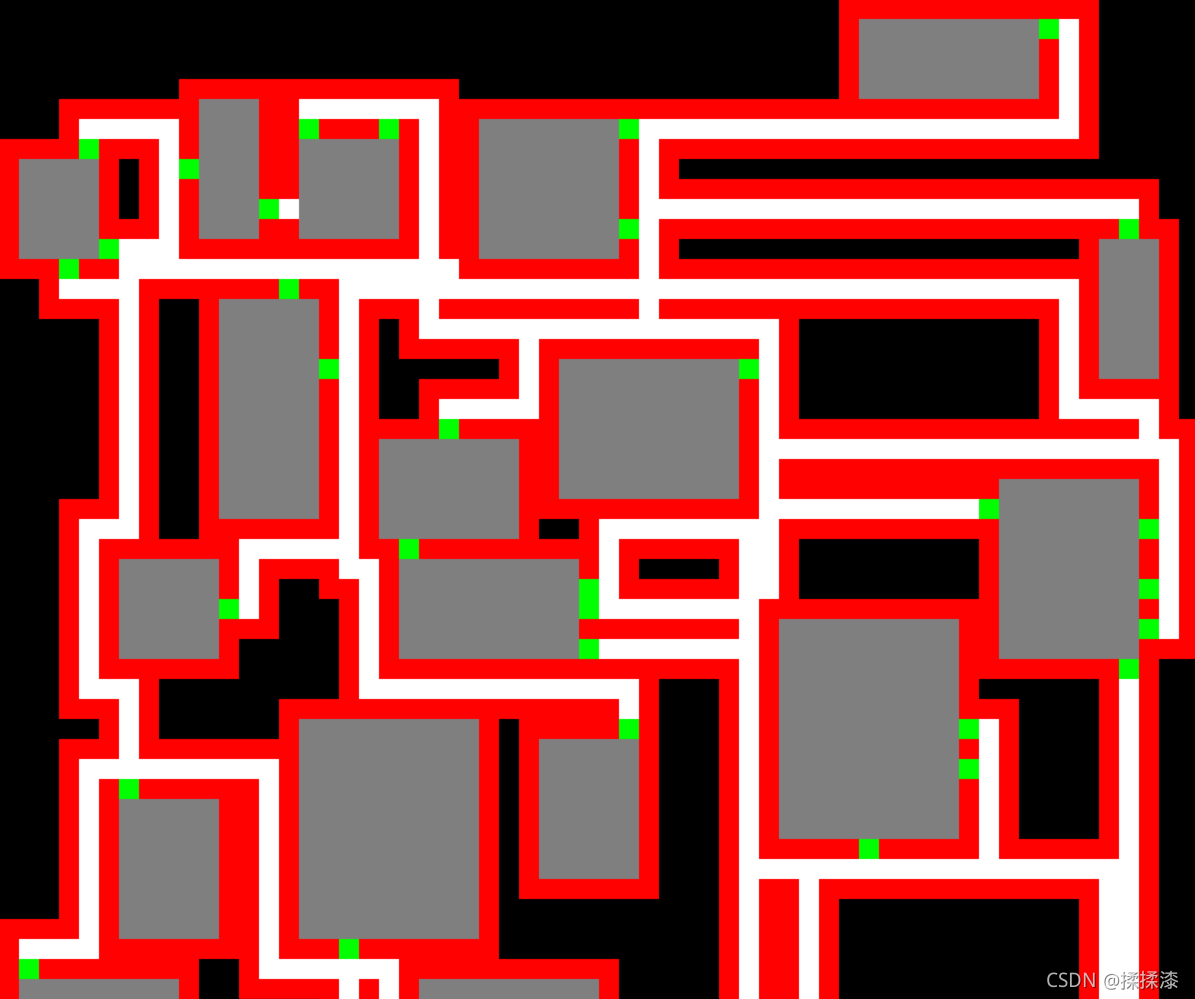python實現地牢迷宮生成的完整步驟
基本屬性
定義當前地牢的等級,地圖長寬,房間數量,房間的最小最大長度,如下
class Map:
def __init__(self):
self.width = 30
self.heigh = 30
self.level = 1
self.roomNum = 5
self.map = np.zeros((self.heigh,self.width))
self.roomMin = 3
self.roomMax = 11
生成房間
編寫initRoom()隨機生成房間,限制最多循環次數,為瞭簡單起見,先做一個不會重疊的房間。基本思路是:隨機房間的中心點,隨機房間的長寬,再進行判斷房間有無重疊(在後續會生成通道,簡單起見在這裡也保證房間不會緊貼),若無重疊,房間有效,房間數加1。貼代碼
def initRoom(self):
count = 0
roomCount = 1
while True:
count += 1
if count > 300:
break
if roomCount > self.roomNum:
break
x = random.randint(1,self.width-1)
y = random.randint(1,self.heigh-1)
wd = random.randint(self.roomMin,self.roomMax)
ht = random.randint(self.roomMin, self.roomMax)
r1 = ceil(y - ht/2)
r2 = ceil(y + ht/2)
c1 = ceil(x - wd/2)
c2 = ceil(x + wd/2)
if r1 < 1:
r1 = 1
if r2 >= self.heigh - 1:
r2 = self.heigh - 2
if c1 < 1:
c1 = 1
if c2 >= self.width - 1:
c2 = self.width - 2
w = c2 - c1 + 1
h = r2 - r1 + 1
if h / w >= 3 or w / h >= 3: #保證房間不是細長的
continue
judge = self.isValidRoom(r1,r2,c1,c2)
if judge == 0:
roomCount += 1
self.room.append(Room(r1,r2,c1,c2))
for i in range(r1,r2):
for j in range(c1,c2):
self.map[i,j] = 1
def isValidRoom(self,r1,r2,c1,c2):
#檢測有無覆蓋
for i in range(r1,r2):
for j in range(c1,c2):
if self.map[i,j] == 1:
return -1
#檢測有無緊貼房間
for i in range(r1,r2):
if self.map[i,c1-1] == 1 or self.map[i,c2+1] == 1:
return 2
for i in range(c1,c2):
if self.map[r1-1,i] == 1 or self.map[r2+1,i] == 1:
return 2
return 0
看一下效果

生成墻壁
編寫initTile()生成包圍房間和通道的墻壁,直接貼代碼
def initTile(self):
offset = [[-1,0],[0,-1],[1,0],[0,1],[-1,-1],[1,1],[1,-1],[-1,1]]
for i in range(self.heigh):
for j in range(self.width):
if self.map[i,j] == 0:
tag = 0
for it in offset:
if i+it[0] >= self.heigh or j+it[1] >= self.width or i+it[0] < 0 or j+it[1] < 0:
continue
if self.map[i+it[0],j+it[1]] != 3 and self.map[i+it[0],j+it[1]] != 4:
tag += self.map[i+it[0],j+it[1]]
if tag:
self.map[i,j] = 3
效果

生成門口
隨機選取房間的一個外圍點當做房門,思路是在房間的長寬內隨機兩個數作為偏移量,預定義好四個方向的覆蓋模板對偏移量進行加權和偏置,在這裡我編寫房間的類,加進地圖的屬性列表裡。
除此之外,房間連通的思路是:在所有房間列表中隨機抽出兩個房間,將這兩個房間連通,再隨機選一個房間加回原來的房間列表,直至最後列表裡隻剩下一個房間。那麼現在先來生成房門,代碼如下
class Room():
def __init__(self,r1,r2,c1,c2):
w = c2 - c1
h = r2 - r1
self.width = w
self.height = h
self.cx = c1 + ceil(w/2)
self.cy = r1 + ceil(h/2)
self.xStart = c1
self.xEnd = c2 - 1
self.yStart = r1
self.yEnd = r2 - 1
def randomTile(self):
direction = random.randint(0,3)
dir = [[0,1,-1,0],[1,0,0,-1],[1,0,0,self.height],[0,1,self.width,0]]
x_off = random.randint(0,self.width-1)
y_off = random.randint(0,self.height-1)
x = self.xStart + x_off*dir[direction][0] + dir[direction][2]
y = self.yStart + y_off*dir[direction][1] + dir[direction][3]
if y == 0 or x == 0:
return self.randomTile()
else:
return [y,x]
class Map:
def initPath(self):
#初始化門
rm = self.room.copy()
while len(rm) > 1:
r1 = random.choice(rm)
rm.remove(r1)
r2 = random.choice(rm)
rm.remove(r2)
point0 = r1.randomTile()
while point0[0] == self.heigh-1 or point0[1] == self.width-1:
point0 = r1.randomTile()
self.map[point0[0],point0[1]] = 2
self.door.append(point0)
self.breakTile(point0)
point1 = r2.randomTile()
while point1[0] == self.heigh-1 or point1[1] == self.width-1:
point1 = r2.randomTile()
self.map[point1[0],point1[1]] = 2
self.breakTile(point1)
self.door.append(point1)
rn = random.randint(0,1)
#a*算法尋找從point0到point1的路徑
#self.aStar(point0,point1)
if rn == 0:
rm.append(r1)
else:
rm.append(r2)
def breakTile(self,p):
# 打通堵住的周圍的墻壁
if self.map[p[0] - 1, p[1]] == 1 and self.map[p[0] + 1, p[1]] == 3:
self.map[p[0] + 1, p[1]] = 2
elif self.map[p[0], p[1] - 1] == 1 and self.map[p[0], p[1] + 1] == 3:
self.map[p[0], p[1] + 1] = 2
elif self.map[p[0] + 1, p[1]] == 1 and self.map[p[0] - 1, p[1]] == 3:
self.map[p[0] - 1, p[1]] = 2
elif self.map[p[0], p[1] + 1] == 1 and self.map[p[0], p[1] - 1] == 3:
self.map[p[0], p[1] - 1] = 2
看下效果

生成通道
接著完善上述函數,在隨機選取房門後,連接兩個房門。
在這我選擇的是A星算法,打通兩個房門,直接上代碼
def aStar(self,p0,p1):
open_list = []
close_list = []
offset = [[-1,0],[0,-1],[1,0],[0,1]]
f = h = abs(p0[0] - p1[0]) * 10 + abs(p0[1] - p1[1]) * 10
g = 0
def isInClose(p):
for it in close_list:
if it.value[3] == p:
return True
return False
def isInOpen(p):
for it in open_list:
if it.value[3] == p:
return True
return False
def findFather(p):
for it in close_list:
if it.value[3] == p:
return it.value[4]
return [-1,-1]
def findInOpen(p):
for it in open_list:
if it.value[3] == p:
return it
return None
open_list.append(Node([f,g,h,p0,[-1,-1]]))
while open_list:
#for it in open_list:
# print(it.value)
open_list.sort(key=(lambda x:x.value[0]))
f_min = open_list[0]
close_list.append(f_min)
open_list.remove(f_min)
for it in offset:
p2 = [f_min.value[3][0]+it[0], f_min.value[3][1]+it[1]]
if p2[0] == p1[0] and p2[1] == p1[1]:
#找到
close_list.append(Node([f,g,h,p2,f_min]))
p_father = f_min.value[3]
while True:
self.map[p_father[0],p_father[1]] = 2
p_father = findFather(p_father)
if p_father[0] == -1:
break
self.map[p0[0], p0[1]] = 4
return
if p2[0] < 0 or p2[0] >= self.heigh or p2[1] < 0 or p2[1] >= self.width:
continue
if (self.map[p2[0],p2[1]] != 0 and self.map[p2[0],p2[1]] != 2 and self.map[p2[0],p2[1]] != 4) or isInClose(p2):
continue
h = abs(p2[0] - p1[0]) * 10 + abs(p2[1] - p1[1]) * 10
g = f_min.value[1] + 10
f = h + g
if not isInOpen(p2):
open_list.append(Node([f,g,h,p2,f_min.value[3]]))
else:
#比較最小的G 值
temp = findInOpen(p2)
if g < temp.value[1]:
open_list.remove(temp)
open_list.append(Node([f,g,h,p2,f_min.value[3]]))
效果

這樣,一個隨機房間的地牢就已經生成,貼上完整代碼
import random
import numpy as np
from math import ceil
class Node():
def __init__(self, val=None):
if val is None:
val = [0, 0, 0, [-1, -1], [-1, -1]]
self.value = val
class Room():
def __init__(self,r1,r2,c1,c2):
w = c2 - c1
h = r2 - r1
self.width = w
self.height = h
self.cx = c1 + ceil(w/2)
self.cy = r1 + ceil(h/2)
self.xStart = c1
self.xEnd = c2 - 1
self.yStart = r1
self.yEnd = r2 - 1
def info(self):
print('r1 c1 r2 c2: ',self.yStart,self.xStart,self.yEnd,self.xEnd)
print('cx cy: ',self.cx,self.cy)
print('width height: ',self.width,self.height)
def randomTile(self):
direction = random.randint(0,3)
dir = [[0,1,-1,0],[1,0,0,-1],[1,0,0,self.height],[0,1,self.width,0]]
x_off = random.randint(0,self.width-1)
y_off = random.randint(0,self.height-1)
x = self.xStart + x_off*dir[direction][0] + dir[direction][2]
y = self.yStart + y_off*dir[direction][1] + dir[direction][3]
if y == 0 or x == 0:
return self.randomTile()
else:
return [y,x]
class Map:
def __init__(self):
self.width = 30
self.heigh = 30
self.level = 1
self.roomNum = 5
#0 is null, 1 is room, 2 is path, 3 is wall, 4 is door, 5 is up stair, 6 is downstair
self.map = np.zeros((self.width,self.heigh))
self.roomMin = 3
self.roomMax = 11
self.room = []
self.door = []
self.initRoom()
self.initTile()
self.initPath()
#self.initTile()
#self.initDoor()
def initRoom(self):
count = 0
roomCount = 1
while True:
count += 1
if count > 300:
break
if roomCount > self.roomNum:
break
x = random.randint(1,self.width-1)
y = random.randint(1,self.heigh-1)
wd = random.randint(self.roomMin,self.roomMax)
if wd % 2 == 0:
wd += 1
ht = random.randint(self.roomMin, self.roomMax)
if ht % 2 == 0:
ht += 1
r1 = ceil(y - ht/2)
r2 = ceil(y + ht/2)
c1 = ceil(x - wd/2)
c2 = ceil(x + wd/2)
if r1 < 1:
r1 = 1
if r2 >= self.heigh - 1:
r2 = self.heigh - 2
if c1 < 1:
c1 = 1
if c2 >= self.width - 1:
c2 = self.width - 2
w = c2 - c1 + 1
h = r2 - r1 + 1
if w == 0:
continue
if h == 0:
continue
if h / w >= 3 or w / h >= 3:
continue
judge = self.isValidRoom(r1,r2,c1,c2)
if judge == 0:
roomCount += 1
self.room.append(Room(r1,r2,c1,c2))
for i in range(r1,r2):
for j in range(c1,c2):
self.map[i,j] = 1
def initPath(self):
#初始化門
rm = self.room.copy()
while len(rm) > 1:
r1 = random.choice(rm)
rm.remove(r1)
r2 = random.choice(rm)
rm.remove(r2)
point0 = r1.randomTile()
while point0[0] == self.heigh-1 or point0[1] == self.width-1:
point0 = r1.randomTile()
self.map[point0[0],point0[1]] = 2
self.door.append(point0)
self.breakTile(point0)
point1 = r2.randomTile()
while point1[0] == self.heigh-1 or point1[1] == self.width-1:
point1 = r2.randomTile()
self.map[point1[0],point1[1]] = 2
self.breakTile(point1)
self.door.append(point1)
rn = random.randint(0,1)
#a*算法尋找從point0到point1的路徑
self.aStar(point0,point1)
if rn == 0:
rm.append(r1)
else:
rm.append(r2)
def initDoor(self):
for it in self.door:
self.map[it[0],it[1]] = 4
def breakTile(self,p):
# 打通堵住的周圍的墻壁
if self.map[p[0] - 1, p[1]] == 1 and self.map[p[0] + 1, p[1]] == 3:
self.map[p[0] + 1, p[1]] = 2
elif self.map[p[0], p[1] - 1] == 1 and self.map[p[0], p[1] + 1] == 3:
self.map[p[0], p[1] + 1] = 2
elif self.map[p[0] + 1, p[1]] == 1 and self.map[p[0] - 1, p[1]] == 3:
self.map[p[0] - 1, p[1]] = 2
elif self.map[p[0], p[1] + 1] == 1 and self.map[p[0], p[1] - 1] == 3:
self.map[p[0], p[1] - 1] = 2
def initTile(self):
offset = [[-1,0],[0,-1],[1,0],[0,1],[-1,-1],[1,1],[1,-1],[-1,1]]
for i in range(self.heigh):
for j in range(self.width):
if self.map[i,j] == 0:
tag = 0
for it in offset:
if i+it[0] >= self.heigh or j+it[1] >= self.width or i+it[0] < 0 or j+it[1] < 0:
continue
if self.map[i+it[0],j+it[1]] != 3 and self.map[i+it[0],j+it[1]] != 4:
tag += self.map[i+it[0],j+it[1]]
if tag:
self.map[i,j] = 3
def isValidRoom(self,r1,r2,c1,c2):
#檢測有無覆蓋
for i in range(r1,r2):
for j in range(c1,c2):
if self.map[i,j] == 1:
return -1
#檢測有無緊貼房間
for i in range(r1,r2):
if self.map[i,c1-1] == 1 or self.map[i,c2+1] == 1:
return 2
for i in range(c1,c2):
if self.map[r1-1,i] == 1 or self.map[r2+1,i] == 1:
return 2
return 0
def aStar(self,p0,p1):
open_list = []
close_list = []
offset = [[-1,0],[0,-1],[1,0],[0,1]]
f = h = abs(p0[0] - p1[0]) * 10 + abs(p0[1] - p1[1]) * 10
g = 0
def isInClose(p):
for it in close_list:
if it.value[3] == p:
return True
return False
def isInOpen(p):
for it in open_list:
if it.value[3] == p:
return True
return False
def findFather(p):
for it in close_list:
if it.value[3] == p:
return it.value[4]
return [-1,-1]
def findInOpen(p):
for it in open_list:
if it.value[3] == p:
return it
return None
open_list.append(Node([f,g,h,p0,[-1,-1]]))
while open_list:
#for it in open_list:
# print(it.value)
open_list.sort(key=(lambda x:x.value[0]))
f_min = open_list[0]
close_list.append(f_min)
open_list.remove(f_min)
for it in offset:
p2 = [f_min.value[3][0]+it[0], f_min.value[3][1]+it[1]]
if p2[0] == p1[0] and p2[1] == p1[1]:
#找到
close_list.append(Node([f,g,h,p2,f_min]))
p_father = f_min.value[3]
while True:
self.map[p_father[0],p_father[1]] = 2
p_father = findFather(p_father)
if p_father[0] == -1:
break
self.map[p0[0], p0[1]] = 4
return
if p2[0] < 0 or p2[0] >= self.heigh or p2[1] < 0 or p2[1] >= self.width:
continue
if (self.map[p2[0],p2[1]] != 0 and self.map[p2[0],p2[1]] != 2 and self.map[p2[0],p2[1]] != 4) or isInClose(p2):
continue
h = abs(p2[0] - p1[0]) * 10 + abs(p2[1] - p1[1]) * 10
g = f_min.value[1] + 10
f = h + g
if not isInOpen(p2):
open_list.append(Node([f,g,h,p2,f_min.value[3]]))
else:
#比較最小的G 值
temp = findInOpen(p2)
if g < temp.value[1]:
open_list.remove(temp)
open_list.append(Node([f,g,h,p2,f_min.value[3]]))
def printMap(self):
for i in range(self.heigh):
for j in range(self.width):
print(int(self.map[i,j]),end='')
print()
def printRoom(self):
for r in self.room:
r.info()
if __name__ == '__main__':
map = Map()
map.printMap()
可視化一下

總結
到此這篇關於python實現地牢迷宮生成的文章就介紹到這瞭,更多相關python地牢迷宮生成內容請搜索WalkonNet以前的文章或繼續瀏覽下面的相關文章希望大傢以後多多支持WalkonNet!
推薦閱讀:
- 一文教你用python編寫Dijkstra算法進行機器人路徑規劃
- python基於opencv批量生成驗證碼的示例
- python Graham求凸包問題並畫圖操作
- python六種基本數據類型及常用函數展示
- Python用 matplotlib 繪制柱狀圖